Vehicles Guides
How to Get Cheap Car Insurance
How to Get Cheap Car Insurance
There are hundreds of millions of drivers with car insurance in the United States. Many drivers receive their auto insurance bill and wonder why they are paying so much. There are a number of steps that drivers can take to ensure that their auto insurance is as affordable as possible.
Raising Deductibles
Drivers should often consider raising deductibles on their auto insurance. Many drivers have low deductibles that make it easy to use insurance. Drivers who rarely place a claim with their auto insurance company should consider raising their deductible. A customer may be able to save up to 40% by changing the deductible on their policy from $250 to $1000.
Drop Additional Coverage
Many drivers who have older vehicles may not be aware of expensive options they have on their auto insurance. A customer who has an older vehicle but still maintains collision/comprehensive coverage on it may pay hundreds of dollars a year more for their coverage. Older cars may not receive a full payout for these claims either. Customers should strongly consider drop collision/comprehensive policies or raising the deductibles on these policies.
Avoid Extra Medical Coverage
Drivers who already have health coverage through work should avoid purchasing health coverage from their auto insurance company. Drivers will receive coverage from their primary health care policy. Drivers only need to maintain the statement minimum personal injury protection liability insurance. Anything extra will only increase the cost of the policy as well as over protect the driver.
Purchase a Vehicle That is Cost Efficient
Drivers who want to save money every month should purchase a vehicle that is cost efficient. An insurance customer who purchases a vehicle that is stolen often will be charged a higher premium. Any driver who decides that they want to have an expensive sports car because it looks cool will have a higher premium. Vehicles that have costly technology or expensive repairs costs are likely to have higher insurance premiums as well. Drivers can save a large amount of money by purchasing a vehicle that is unlikely to be stolen and has a good reputation for repair.
Drive Less
Drivers who drive less are able to save money on their policy. A driver who drives only 5,000 miles a year in their vehicle will pay a lower premium than drivers who drive 12,000 miles a year. Drivers also will have a lower likelihood of being involved in an automobile accident. Drivers who carpool may also receive a discount on their auto insurance. Customers should contact their auto insurance company to inquire about a potential discount.
Notify Your Insurance Company about Safety Features
Many insurance companies are automatically able to see which safety features are installed in your vehicle. However, some insurance companies do not automatically apply these discounts. Many auto insurance companies allow drivers to receive a discount for having air bags, ABS brakes or an alarm system. Insurance companies may even bundle these discounts together to give the customer even further savings.
Add Teens to Parents Policy
Many parents may not want to have their teenager on their auto insurance policy. However, teenagers who are on their own policy typically have to pay over $1,000 more a year for similar coverage. Teenagers who have good grades as well as pass a drivers education class can qualify for discounts. College students may also qualify for discounts depending upon the auto insurance company.
Carry All of Your Insurance With One Company
Many companies provide a loyalty discount for having multiple policies with the same company. This means that a customer who has a homeowners’, life insurance and auto insurance policy with the same company could save hundreds or thousands of dollars a year. Best of all, many insurance companies are willing to give you discounts on your other policies as well. Price shop other insurance companies and notify your current insurance company that you have found a better price elsewhere. You may be able to save money simply by asking for a discount.
Ask for a Discount
Customers should always ask for a discount. Many companies may deny a discount or only apply a small discount to your account. However, customers may be eligible to save hundreds or thousands of dollars a year. Often a customer has to make a simple phone call that takes less then ten minutes in order to save a large amount of money.
Avoid Coverage for Rental Car Reimbursement or Towing
Drivers should strongly reconsider adding rental car reimbursement or towing coverage to their policy. Many drivers may already have a credit card that covers them in the event of their vehicle breaking down. Check with your credit card carrier for more information to determine whether you truly need this coverage.
Tips to Remember
Drivers should remember to check with their insurance agency about all of the tips that are mentioned above. Many drivers are able to save hundreds of dollars a year on their auto insurance premiums. Cost savings can add up quickly when drivers raise deductibles, drop coverage and simply ask for a discount. Customers should always remember that the insurance market is very competitive and there are many car insurance companies who are willing to give you a quote for cheaper insurance rates.
How to Jump Start a Car
Car batteries can lose their charge for many reasons. Leaving the lights on is the main culprit — though a battery can die for any number of reasons.
To jump start a car properly, you’re going to need a few things:
- A car with the same voltage battery as your own, fully charged (most cars will match your own)
- A set of jumper cables
- A wire brush (Optional)
- Safety glasses (Optional)
- Rubber gloves (Optional)
You should keep your own set of jumper cables around, because asking someone to help you jump your car AND to let you use their cables is kind of a bit too much to ask. Buy a solid set of heavy gauge copper jumper cables at least 10 feet long. No matter the cost, the first time you get an easy jump start the cables will have paid for themselves.
Jump Starting a Car Battery
Your first step when jump start a car is to check the battery.
Batteries contain sulfuric acid. If that sulfuric acid is frozen, don’t try to jump the battery. This is a serious safety hazard and can cause an explosion.
Another no-no — don’t jump a battery that has a cracked case. You’re just going to have to buy a new battery.
Cleaning the Car Battery
Some batteries will have a buildup of material around the terminals — usually, this stuff is white, green, blue, or even black. If you have a wire brush, it is safe to clean this stuff off — you don’t want to touch the powder, as it can burn and hurt your skin. This is the step during which you’ll want to be wearing gloves. Take note — when this battery junk starts to form, it may be time to buy a new battery anyway.
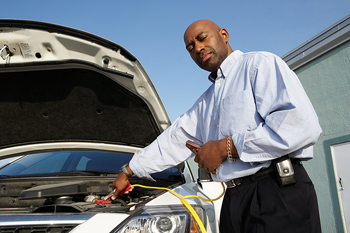
How to Jump Start a Car
Once you’ve found a car to jump start you, thank the person, and line up the cars with both engines facing each other (but not touching). Make sure the ignitions are completely off.
Connecting the Terminal
Each car battery has two terminals, one is marked with a + and the other is marked with a -. The positive terminal usually has a cover over it and a bunch of other wires sticking out of it. The negative terminal is typically a plain uncovered black thing. Check the symbols to make sure.
Now attach the cables in the correct order. This step is very important.
- Attach one end of one cable to the dead battery’s positive terminal.
- Attach the other end of the same cable to the positive terminal of the good battery.
- Attach one end of the other cable to the negative terminal of the good battery.
- Attach the other end of that cable to the engine block of the car with the dead battery. How do you know what to attach it to? Look for any unpainted bare metal and attach the cable to that. Whatever you do, don’t attach the negative cable to the dead battery itself.
- Stand back from the hood areas of the cars. This is also the point at which safety goggles are called for, just to be safe.
- Start the car that’s providing the jump start.
This should do the trick. You may need to wait about five minutes before you try to start the car with the dead battery. If it does not start, stop trying and wait a few minutes longer. Try again for no more than thirty seconds. If the car still doesn’t start, chances are that the battery is dead for good. Re-check your connections, or just call a tow truck.
How to Get Out of a Speeding Ticket
So you want to know how to get out of a speeding ticket. Join the millions of Americans in the same predicament. To try getting out of a traffic citation, you’re going to need to understand the person you’re dealing with.
Police officers are human beings, just like the rest of us. Yes, they survive on a substrate of coffee sludge, donut holes and regret. Yet, deep down, beneath all those layers of uniformity and repression, they will crack like your grandmother if the right tactics are applied.
Here’s four ways to get your way out of a speeding ticket. All are driver-tested and most of them are cop-approved. Remember that the best way for avoiding speeding tickets is to drive safely and not break the law.
1. Know What to Say (AND What Not to Say)
When you do finally get busted for speeding – and you know it will happen eventually – there are a few things you should and should not say and do.
Never admit to guilt — the cop will ask you “Did you know you were going xx miles per hour back there in a school zone?” or “How fast were you going back there?”
These are both trap questions that are admissions of guilt in the eyes of the court. There is no law that says you must give a cop an answer to a question in this situation. This doesn’t mean be rude to the cop: speak with respect, call the cop “officer” and cooperate with all his commands.
Don’t fall into the trap and say “No, I wasn’t going 78 mph, I was going 70” or anything like that. That’s just being argumentative, and he’s going to trust his radar over your word. You may as well write yourself the ticket if you do that.
If you don’t give them something to use against you in court, the officer might decide it’s not worth writing you the ticket and going to the trouble of a court date. Act savvy and don’t admit anything, and he might think you’re going to get a lawyer and fight it. No admission of guilt really helps that lawyer.
2. Say the Right Things

How to Get Out of a Speeding Ticket
In some cases, acting “dumb” could help you out. Play up your unfamiliarity with a certain road, or say that you’re just really tired after work and wanted to get home.
Apologize and outright ask for a warning. Your honesty, combined with a bit of heart on the cop’s end, could get you out of this ticket.
Don’t argue with the cop. If he’s writing you the ticket, he’s not going to take it back. If you are getting a ticket, don’t say a word, sign the paper, and prepare to fight it in court if you must.
3. Use Your Feminine Charm (If You’ve Got Any)
Here’s one area where the ladies (sometimes) have an advantage. Since most traffic cops are red-blooded American males, sometimes women have found that showing a little skin (in an underscored way) or crying at just the right time can help get them off easy.
Some people may say this is degrading, but I say you should use the tools God gave you. Don’t go overboard and don’t outright bribe a cop, but there are subtle ways you can convince the cop that you don’t really need a ticket.
4. Last-minute Tricks
I have heard some crazy last minute ticket avoidance strategies. I had a friend of mine who soiled himself and told the cop he “really needed to find a bathroom”. I knew of someone who kept bees or other insects in jars in their cars and letting them go to convince the cop that they were speeding because of a bug in the car.
Sometimes these dumb tactics work, but most of the time this is effort simply better spent on being a better driver.
Remember, if all of the above fails, you can still challenge your ticket in court. About half the time the cop doesn’t have the time to show up and give his side of the story, so your ticket will be wiped away. Only every now and then will you win your case if the cop actually shows: the police are considered good witnesses for the state.
5. Don’t Break the Law
The easiest, cheapest and least humiliating way to get out of speeding tickets has always been to simply obey the law. Don’t go over the speed limit, check all your driving actions before you make them, pay attention to the road around you, and (if nothing else) don’t speed around cops.
There’s nothing wrong with being aware of when police officers are around you: it just means that you are a cautious and aware driver. A way for avoiding speeding tickets, is just to think about simply not speeding.
6. Never Try to Run
The worse to get out of a speeding ticket is to try running. That’s going to take a minor traffic ticket and turn it into a major set of fines and a stay in jail. Never try to run from the law.
How to Replace a Clutch
Given the current economic climate, learning how to replace a clutch lets you cut out the high costs of paying a mechanic. Big jobs, like replacing the clutch in your vehicle, is not recommended, though.
Replacing a clutch is a rigorous, involved task which requires a sound mechanical knowledge and an extensive tool kit, which surpasses your average garage wrench set. I recommended you seek the assistance of a certified mechanic; in the end, it’s worth it.
How to Replace a Clutch Anyway
If you categorically refuse to go to a mechanic, purchase an official automotive repair guide which pertains to your vehicle’s exact make, model and year. You need to be familiar with automotive repair prior to undertaking this project. Consult a mechanic or official automotive repair manual, if you have any questions or concerns. This might save your life.
Go to the local library and check out a book on automotive repair, especially one that focuses on clutch repair, if you don’t want to buy a book on mechanics. Once you have the knowledge of how to repair a clutch, you’re ready to start the project.
Replacing a Clutch
In order to access the clutch, you have to remove several parts: the driveshaft, bell housing, flywheel and transmission all have to be removed. This may sound simple, but it’s a tricky procedure, with slim margin for success, if you’re new to automotive repair.
Once you have those parts removed, make sure your flywheel is still good. Once broken down, you can tell if a flywheel is in working order. If a flywheel is warped, cracked or otherwise damaged, get a new one. New flywheels are expensive.
Inspect the bushings found on or along the transmission, to make sure they aren’t cracked or torn. When putting everything back together, it’s crucial to make sure that all of the parts are aligned, exactly as they were.
If they aren’t, you have big problems. Something is going to break and cost you a great deal more money, which in turn defeats the financial savings learning how to replace a clutch and replacing the clutch yourself.
Step 1

How to Replace a Clutch
Secure your vehicle on an automotive hoist, making sure that the arms of the hoist are placed underneath the secure load-bearing areas of your vehicle. Be extremely careful in this step, because you don’t want to be underneath a car when it falls – period.
Secure the engine with a jack or another means of preventing it from falling during the repair process. Remove the transaxle from the engine, pushing it away until it clears the pressure plate.
Step 2
Remove the clutch disc and pressure plate. Make sure that the flywheel is in working order, checking for damage such as cracking, warped metal or any other deformities, which might interfere with its functioning.
Make sure everything is lubricated. Make sure that the transaxle isn’t leaking. Remove the seal on the flywheel and replace it with a new one.
Step 3
Ensure that the flywheel and crankshaft are cleaned, before assembling them. Put in the pressure plate and clutch disc, according to your automotive manual’s directions. Re-install the transaxle into its proper position, without forcing it.
Step 4
Re-attach any nuts and bolts that are left over. Leave no part lying around, after the project is over. That piece has somewhere essential it needs to go.
Make sure that the clutch cable has the proper amount of play. You don’t want it to be too tight or too loose. Buy a new one, if your budget allows.
If not, be careful. Make sure the clutch is assembled. Check everything, to see if it’s in working order, before having it inspected by a certified mechanic for safety. You want to follow this last step, or you have no assurance your new clutch is safe.
Clutch Repair
There are many more nuances required to replace a clutch that are crucial to the overall success of the operation. Consult an official automotive repair manual, or take your car to a mechanic to be repaired, after replacing the clutch in your car. It might be more expensive, but in the end, your life is worth the extra money.
You may find it strange to read a “How to Replace a Clutch” article and have it recommend you use a mechanic, but I want our readers to be safe and healthy, so that’s what I recommend here.
How to Replace a Head Gasket
Replace a faulty or blown head gasket immediately, since failure to do so can ruin your vehicle’s engine. A bad head gasket damages the cooling system, engine block, pistons and other vital engine components. When a gasket is blown, the engine goes soon after.
If you don’t take care of business soon, an expensive repair becomes an extremely expensive repair. So if you want a cheaper alternative, learn how to replace a head gasket yourself. Replacing a head gasket is an complicated procedure, though, which is best trusted to a certified mechanic
You should know that replacing a head gasket requires taking apart most of the engine. This is one of the biggest car repairs, short of replacing the engine. Don’t undertake these repairs, unless you know for certain you need a new head gasket. So how do you know you need the repairs?
Head Gasket Warning Signs
Signs that your head gasket needs to be replaced are white colored exhaust issuing from your vehicle’s tailpipe while the engine is running, or a thick creamy fluid in either your radiator or oil reservoir. If either of these appear, you have problems.
Unless there’s a clear cut case of a blown head gasket and you know for a fact that’s the problem, though, it’s best to have a mechanic diagnose your problem. You don’t want to go to all of the trouble to learn how to replace a head gasket, and then the further trouble of replacing a head gasket, for nothing.
As I stated above, given the complex nature of replacing a head gasket, this article serves to merely outline the steps taken in order to replace a head gasket. Our advice below is not meant to serve as step by step instructions for the aspiring home mechanic. Seek professional assistance in performing this procedure, to avoid personal injury and property damage.
Bad repairs are likely to cost you more than you would have payed in the first place. Read ahead and see whether you feel up to this task.
Head Gasket Installation
The following head gasket instructions list the steps necessary to remove and replace a head gasket. If at any point these head gasket instructions are unclear to you, please contact a certified mechanic.
In order to get at the head gasket itself, you remove the intake manifold, exhaust manifold, valve train and head of the engine, which is an involved procedure and the prime consideration of learning how to replace a head gasket. In order to do this, a multitude of sensors and other parts of that nature need to be disconnected, which can be disastrous if done incorrectly. Once this is done, the mechanic should see if the head itself is warped or damaged in some other way which has lead to either one or both of the head gaskets needing to be replaced. However, things get even trickier in the sense that they also have to examine the rest of the engine to make sure that no additional damage has been done to the engine, either as a cause or result of the head gasket failing.
If you decide to proceed, don’t skip any of the head gasket installation steps outlined below.
Step 1
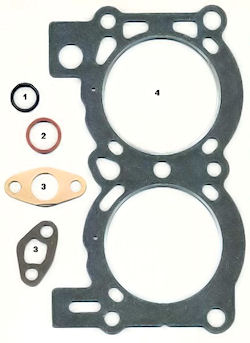
How to Replace a Head Gasket
Raise your vehicle up on an automotive hoist, making sure that the arms of the hoist are resting underneath sturdy, load-bearing areas of your vehicle. Don’t get near your car when it’s on an automotive hoist, unless you are certain everything is secure.
Remove the battery to prevent accidents from occurring. Once the battery has been removed, drain all of the coolant out of the vehicle.
Step 2
Remove the exhaust pipes, air intake and the filtering system. Remove the air compressor and any other items in that region, to get them out of the way of your progress.
Step 3
Disconnect any attachments that are connected to the alternator and remove it. Remove the valve cover and its associated parts, such as the pushrods etc. Once again, if you have no experience and you don’t have the know-how to put these back together without looking at a schematic, you shouldn’t be attempting to do this yourself. Self-repairs likely will result in the destruction of your engine.
Step 4
Remove all timing components and remove the head bolts. Remove the head itself and check to see if it is warped, cracked or damaged in some other way. If it is, the head might need to be replaced as well, which is expensive.
Remove the old head gasket and clean off the area where it sits, making sure to get all of the scummy accumulation off of it.
Step 5
Following the manufacturer’s instructions, replace the old head gasket with the new one, making sure that it is lined up perfectly, because if it is misaligned, your engine could get ruined.
After securing the new gasket, re-assemble the engine in the opposite order from which it was disassembled, as the last step of learning how to replace a head gasket.
How to Replace a Head Gasket
It might only look like 5 steps to replacing a gasket on paper, but this kind of engine work is far more complicated than it reads above. This is going to be a time-consuming, tricky and dangerous operation on your car.
Instead of spending your time and money learning how to replace a head gasket and buying the tools to help you do so, I recommend using your time to make money to afford repairs, and using your money to hire a certified auto mechanic.
How to Replace a Radiator
A properly functioning radiator is critical to the correct operation of your vehicle’s engine. A radiator dispels the heat of your engine, or radiates heat, so if your radiator is broken, your engine gets too hot and that heat damages the engine. Knowing how to replace a radiator is a crucial skill for any mechanic.
The radiator prevents the engine from overheating, by taking in hot engine coolant and channeling it through a series of tubes. This is done in order to cool down, so the coolant can be re-circulated through your engine, to prevent major damage from occurring due to overheating issues.
But what do you do when your radiator needs to be replaced? The prudent choice would be to take it to a certified automotive repair center. Certified mechanics replace radiators all the time, according to the factory specifications set forth by the automotive manufacturer that produced your vehicle.
Why Hire a Mechanic?
Unless you’ve been around car motors your whole life, or you have training as a mechanic, performing your own serious motor engines repairs is like those old Holiday Inn Express commercials, where the guy thinks he can perform open heart surgery, because he was smart enough to choose the right hotel. Believe me, you don’t want to stay at that Holiday Inn Express.
However, if money is an issue, learning how to replace a radiator is an option. Replacing a radiator can be a complicated procedure, depending on the type of car that you have, but at least you’re not trying to replace the head gasket or engine block.
Remember, replacing a radiator and failing can cause more damage to your car or injury to yourself. Make sure that you’re familiar with all the aspects of car repair, before attempting to replace a radiator. These instructions alone may not be enough to ensure that you perform such a task.
Step 1
Consult an automotive repair manual to familiarize yourself with where your radiator is located, as well as the other cooling system components. Do not remove the radiator cap until the car has cooled down. Otherwise, the cap is under a lot of pressure and could burst, causing blunt force trauma and severe burns from the hot coolant spraying out.
For the most part, the radiator is located in the front of the engine cavity.
Step 2
Disconnect the negative battery terminal to make sure that there are no accidental grounding issues. While you do this, don’t allow the wrench to contact the positive terminal, as this can result in the battery exploding and spraying acid everywhere.
When I used to volunteer in an emergency room, a guy came in one day who had touched his wedding ring to part of a car engine, and he severely burned his finger, where the wedding ring touched his skin. All he was doing was trying to loosen something with a screw driver, but the battery was still connected, sending jolts of electricity into whatever he had touched. Just keep that in mind when deciding whether to unhook the battery or not.
Once this safety precaution has been completed, you are ready to proceed.
Step 3
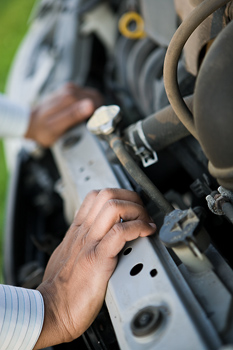
How to Replace a Radiator
Turn the radiator drain valve in a counter clockwise direction, to allow the radiator fluid to drain out. Some vehicle models have radiator and fan mounts, which are located in the way of the hose connections and the drain valve. If this is the case, remove these bolts to allow you to access them.
Once the fluid has drained out, remove the lower hose connections. After removing the lower fan bolts and lower hose connections, remove the upper hose connections and fan bolts
Step 4
Find the radiator mounting bolts and remove them. Keeping the fan out of the way, remove the radiator from the engine cavity. Check to make sure that no unwanted debris has fallen into the space previously occupied by your radiator.
Step 5
Check to make sure that the radiator was not damaged during shipping. Affix the cooling fan assembly to the radiator, making sure that the fans are not impeded by anything, and that the whole assembly is clean and free of debris.
Step 6
Re-connect the hoses, bolts and mounts. Once this is done, make sure that everything is put back properly or, better yet, consult a certified mechanic or official automotive repair manual that is pertinent to your vehicles’ particular make, model and year.
After consulting sources outside this article and making sure everything is in place, fill the radiator with coolant or a mixture of coolant and water and start the engine, leaving the radiator cap off. Let the engine warm up a bit, then replace the cap.
Check to make sure coolant is not leaking out. Make sure that the reservoir is at least half full with coolant when warm. Check again, after the engine cools down.
Dispose of the old engine coolant, as coolant is toxic. Dumping coolant into the ground is a mistake, since the toxic coolant makes its way into the groundwater supply and poisons it.
The responsible thing to do is to take it to a specialized treatment facility. Consult your local automotive repair shop or recycling facility for tips on where to take the old coolant, as well as for advice on how to replace a radiator.
Remember, it’s important to wear proper protection such as gloves and safety glasses throughout the procedure.
How to Replace a Starter
Without a proper working starter in your car, your vehicle isn’t starting up and going anywhere. Learning how to replace a starter yourself can help offset the costs of this frequent repair. You might be wondering how to know when your starter isn’t working.
When your car doesn’t start, it can be several faulty parts: a partial list of suspects would be the battery, the solenoid, the engine switch, the flywheel and the starter.
If the battery is the problem, nothing usually happens when you attempt to start the car. However, if there is a charge and you try to start the car, you get a clicking sound or nothing.
The clicking means that the car has the power and is trying to start. There’s a good chance the starter is fried. But if your car won’t start, don’t automatically assume that it is the starter.
It’s a good idea to check certain parts under the hood, to make sure it isn’t the starter. Check the battery, the battery connections, the starter solenoid and any other component that might have to do with starting your car.
Other options include, but are not restricted to, spark plugs, a dirty air filter or even blown gaskets. Once you have established that those are running properly, by process of elimination, the starter is at fault, and it’s time to get to work.
Study How to Replace a Starter
Disconnect the battery. If you don’t disconnect the battery first, you run the risk of getting a nasty shock. In fact, you could severely hurt yourself.
Take wheel chucks and place them behind the back wheels, so that the car doesn’t roll backwards, when hoisted up. Jack the front of the car up, so you can gain access to the starter from underneath.
While working under the car, it’s important that you be careful not to touch any electrical connections.
Locating the Starter
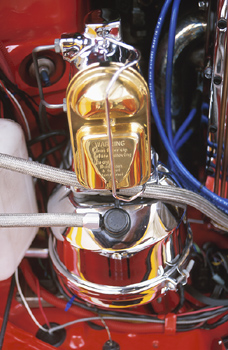
How to Replace a Starter
Locate the starter. The first place to look is on the driver’s side underneath the manifold. The starter will look like an 8 inch cylinder about 6 inches across. One end of the starter will have air holes and there will be two electrical connections and a mounting connection. In older model cars, it may be possible to get to the starter from the top but it will most likely be down in the engine compartment itself, which means you will have to hoist the car up on jacks.
Removing the Starter
The two electrical connections going to the starter need to be removed and tagged, so you know where to connect them to the new starter later. You want to tape these to something, so they don’t get in the way while you’re working. When you’re done removing the electrical connections, use a ratchet or crescent wrench to remove the mounting connection from the starter.
If the vehicle is old or there is corrosion on the mounting connection, spray DW-40 around the connection point, so it can be removed easily. Be careful not to strip the bolt because, if you do, you’ll have to take your car into a garage to have it professionally fixed. Once the connections have been removed, take out your old starter.
Replacing a Starter
The first step to replacing a starter is to put the starter in where the old starter was. Make sure to install the new one in the reverse order that you took the old one out. Connect the new starter to the mounting connection, but only tighten the nut slightly. Once you have that done, replace the electrical connections, starting with the ground cable.
Make sure you remove the tape, so that it doesn’t melt and burn up later when running your car. Once you have everything attached, go back and tighten up every connection, to make sure that nothing comes loose in the future.
Once the new starter is connected, go back and connect anything you may have disconnected, such as the battery. If you removed something and forget to reattach it, you might cause more damage to your car than there was before.
Always double-check your work and make sure that all connections are in the right place and secured tightly. Start up the car, to make sure that the starter works and is running properly.
Once you’re done checking your work and making sure everything is working properly, turn off the car and lower it from the jacks. Start it up again and remove the wheel chucks from the back tires, so that you can back up, if need be. Let your car run for a while, to get the starter warmed up and broken in, so that you can listen to see if there are any problems.
If the car starts up without any problems, you now know how to replace a starter.
How to Replace a Timing Belt
Learning how to replace a timing belt is a tricky prospect. A vehicle’s timing belt is crucial to the efficient operation of the engine. Be sure to change your timing belt in accordance with your automotive manufacturer’s recommendations, or when your belts begin to show signs of wear.
Timing belts control your camshaft, which operates the intake and exhaust valves in your engine. Without a functioning timing belt, your engine can’t run. If the timing of your engine is off, it wreaks havoc with that engine.
While it’s tempting to learn how to replace a timing belt yourself to save some money, replacing a timing belt is a difficult and time consuming endeavor. The average car driver doesn’t have a sufficient selection of tools to streamline the procedure, which increases the difficulty as well.
Therefore, take your vehicle to a certified mechanic who knows how to replace a timing belt, since this is the best way to ensure the job gets done quickly and correctly. People who want to take their vehicle to a certified mechanic for whatever reason, this article is intended to be used as an overview of the steps involved in changing a timing belt yourself, and not to serve as a set of definitive step by step instructions.
Timing Belt Replacement
Before you begin, it is crucial that you purchase an official automotive repair manual that specifically deals with your vehicle’s particular make, model and year. Also, all home repairs should be inspected by a mechanic for safety purposes. You should also consult a mechanic if any point during this timing belt replacement guide you feel unsure about what you’re doing.
Step 1
Put your vehicle on a secure automotive hoist. Make sure the engine is supported. Your automotive repair guide should cover this. Drain the coolant out of your radiator.
Make sure to allow the engine to cool off overnight, to prevent being scalded with pressurized coolant. Make sure that you empty the coolant from your radiator into an appropriate container and properly dispose of it. Put it back into your radiator towards the end of the procedure, if the coolant is still good.
If needed, remove the entire radiator and cooling fan assembly. This is not always required, it depends on the make and model of the vehicle. Consult your automotive repair manual for details on whether or not this needs to be done.
When removing your timing belt, you might have to remove your A/C belt as well. Check the manual for this information.
Step 2
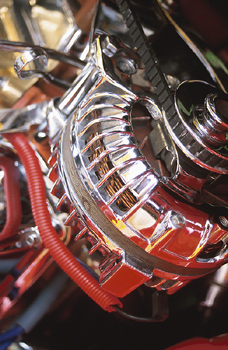
How to Replace a Timing Belt
Once the radiator is removed, remove the valve cover. Take out the spark plugs and disconnect the ignition wires in your engine. Loosen the bolts on the water pump, then remove the belt, before taking the actual pump out.
Loosen the bolts on the alternator and remove the water pump pulley and accessory belt pulley.
Step 3
Take off the timing belt covers, so you can get at the timing belt itself. There might be more steps involved prior to this point, so once again refer back to your automotive repair manual.
Make sure that your transmission is in neutral. Rotate the crankshaft pulley, until the E and I markings line up. Loosen the tensioner lock bolt and remove the timing belt.
Step 4
Consider changing your water pump, while you have this part of the engine apart. Look at the various seals, to see if they need to be replaced as a result of everyday wear and tear.
Consult your automotive repair manual for a list of water pump parts, or ask your mechanic.
Step 5
The steps required to reassemble your timing belt vary by the make, model and year of your vehicle. Look to your automotive repair manual for specifics. However, the process involves first replacing the inner guides of the timing belt, then the covers, while making sure to apply sealant where needed.
Ensure that the outer guide plate and crankshaft assembly get put back on. Following this, the ignition wires, coolant system and various other components get put back together. Make sure to refill your radiator with coolant as well.
Once everything is back in place, it’s a good idea to have a mechanic inspect your work, to make sure everything is put back together correctly. Even if you know how to replace a timing belt, it’s a good idea to have a trained eye double-check your work.
How to Replace an Alternator
A malfunctioning alternator is a common problem with countless vehicles nationwide. Learning how to replace an alternator is a useful skill, because you’re likely to have an alternator go bad on a vehicle sometime in your life. When a vehicle’s alternator stops working, the battery no longer gets charged and is soon drained of power, so your car won’t start.
While replacing an alternator isn’t too difficult of a mechanical procedure, it’s expensive to have done by a mechanic, especially if you purchase a brand new one. For those who have some mechanical knowledge, a good set of tools and an official automotive repair guide, the procedure can be done at home. Save a little money by buying a re-furbished alternator and trading your old one in, which can earn you even more of a discount.
That last part is important. Even if you’re a skilled amateur mechanic, consult an official repair manual which covers the particular make, model and year of your vehicle, unless you’ve replaced alternators on this model more than once. An auto repair guide provides specific and accurate details on the steps you need to take. For safety’s sake, have your work inspected by a certified mechanic, just to make sure everything has been installed right.
With that in mind, here’s a step-by-step guide for how to replace an alternator.
How to Replace an Alternator – The Process
The following will guide you through process of replacing an alternator.
Step 1
Disconnect the battery to prevent accidental grounding issues, which can result in a number of battery accidents. Wear proper protective gear, such as safety glasses and gloves.
Unhook the wires leading to the alternator, making sure you remember where they all go. It’s prudent to make notations about where they go or label the wires in some way. It’s up to you but the extra effort up front will be worth it when you don’t have to pull your hair out trying to get the wires back into their proper place.
Step 2
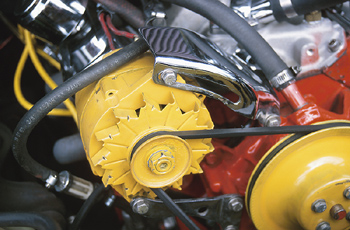
How to Replace an Alternator
Remove the belt from the alternator. This is a tricky step. Take your time and don’t force it. Forcing the mechanics here can damage the pulley system, costing you more money.
Unhook the bolts that secure the alternator to the engine. There’s a good chance the bolts might be corroded and stubborn, so giving them a light spray of an approved automotive repair lubricant helps in getting the bolts off.
Also, torque wrenches are a good idea, to prevent you from stripping the bolts by applying too much force. Stripping out the bolts is a common mistake with inexperienced or otherwise impatient mechanics, and this makes your job all-the-more difficult and expensive.
Step 3
Remove the defective unit and place it out of your way. If you plan on buying a new alternator, take the old one with you to the auto parts store, to show the sales person. This lets them know exactly alternator you need.
Another option is to hunt around junk yards to find a working alternator. This can be more cost effective, but there’s no guarantee the part in question actually works. Make sure you’re buying from a junkyard you trust, or have the alternator in question inspected to make sure it works.
One word of caution: unless you are an experienced mechanic, don’t try to take your alternator apart yourself. There are many delicate parts inside an alternator and, if jostled, the parts break.
Once again, get a re-furbished one cheaper by trading your old one in, if that’s an option. This saves you more cash.
Step 4
Install the replacement alternator, by following the steps listed above, but in the reverse order. Make sure to refer to your automotive manual throughout this process. Follow any instructions they give you over the information found in this article.
Take your time and maintain your patience. Take a break, if you feel your temper starting to boil. Don’t get in a hurry, because that’s when mistakes are made.
When dealing with the belt pulley system of the alternator, make sure that you tension it correctly, according to the directions outlined in your automotive repair manual. Have your work inspected by a mechanic, to make sure that everything is dialed in and working properly.
Be careful when hooking up the alternator wires, making sure the wires go in their proper place. This precaution avoids problems, while it give you more experience inspecting your handiwork. Once you get the parts back into the engine and the engine works, you officially know how to replace an alternator.
How to Replace an Ignition Switch
If your car is having trouble starting and previous attempts at troubleshooting have failed, there is a good chance your ignition switch needs replacing. You’ll need to know how to replace an ignition switch. This can be done at home, though replacing an ignition switch is time-consuming, pain-staking and dirty.
Don’t say I didn’t warn you.
First, let’s see if your car’s ignition switch is the problem. I’ve listed some symptoms your ignition switch is failing below. Any one symptom could point towards other part of the machinery, so check several symptoms, to see if they all point to the ignition switch.
- Your car stalls out and no service lights appear on the dashboard
- When removing your key from the ignition, it feels abnormally warm
- Your speedometer drops down every so often
- Your car dies after you start your it and let up on the key
How to Replace an Ignition Switch Yourself
Although people often pay professional mechanics to replace an ignition switch, you can learn how to replace an ignition switch yourself. Replacing an ignition switch, as stated before, is a complex task – though not an impossible task.
What you will need:
- A new ignition switch
- Multiple size wrenches
- A small and large screwdriver (Look at your new ignition switch to determine exactly how thin the small screwdriver needs to be.)
- Prying bar
- Baking Soda
- Grease
- Safety goggles
- Gloves
Removing Your Old Ignition Switch
-
Disconnect the negative (-) battery cable from the battery. Clean any corrosion around the battery, by using a baking soda and water mixture. Avoid touching the corroded material, since it’s highly acidic and dangerous. (Any clothes which touch the acid will develop holes after a few washes.) After the area is clean, it is safe to disconnect the negative wire.
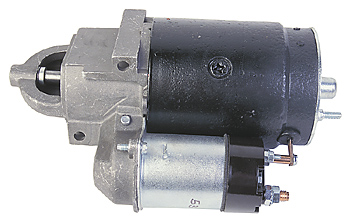
How to Replace an Ignition Switch
- Unscrew the steering column covers.
- Remove the car’s steering wheel by lifting off the cover, undoing the horn wire and then taking out the retaining nut and washer. Use a large screwdriver and a lot of pressure to remove the retaining nut, if needed. Remove the steering wheel from its shaft. Remove the rubber cover from around the steering wheel shaft. Make a mark on the adaptor so that you remember where to place the steering wheel. Turn the steering shaft so that the word “top” or the arrow is centered.
- Behind the steering wheel, take off the turn signal/windshield wiper poles. Pull them out of their sockets and detach the wiring.
How to take out the old ignition switch:
- Unscrew the stalks around the old ignition switch with your screwdriver. The screws may not be the same size, so remember where you took them from. Remove the plastic spacer around the steering shaft, avoiding any of the three apparent holes. If you don’t, this causes you to have to replace the entire piece. Pry it out gently using a prying bar or a short, thick screwdriver. Sand down the steering shaft before you replace it, to remove any hard dirt. After taking out the spacer collar, remove the head bolt from the left side of the steering shaft. There is one more screw on the back of the switch that needs to be removed and then the ignition switch should slide out easily.
- Disconnect the ignition switch wires, by taking off the wire tabs and pulling them out. In some cars, the wires can be tugged and come loose easily. In others, you’ll have to remove them manually.
- Put your key into the disconnected ignition and turn it to the locked position, which is usually all the way counterclockwise.
- Using your screwdriver, lower the retaining pin. Turn your key into the “off” position in the ignition and this should release the cylinder. To remove the cylinder, turn the key back into the locked position and take out the cylinder.
Installing Your New Ignition Switch
After inserting the cylinder into the new ignition switch, screw in the retaining pin in order to hold the cylinder in place. Be very careful to ensure that the ignition switch and cylinder line up exactly. You may want to grease the area of the ignition switch that attaches to the lock as this is the place of the ignition switch that gets the most use
- Reattach the ignition switch to the ignition wires on the right side of the steering wheel shaft. Slide the new ignition switch into place. Reinsert the mounting screws. Be careful to ensure that the ignition switch is held tightly in place.
- Grease the spacer collar before reattaching it. Using a wrench, tap the spacer evenly until it falls into place.
- Reattach the windshield wiper and turn signal switches to their wires and slide them back into place. If necessary, trim the switches at this time. Reconnect the steering wheel to its wires and, using the mark that you made on the adaptor, reinsert it into the steering shaft.
- Reconnect the negative battery cable and start your new ignition to ensure proper installation.
As you can see, learning how to replace an ignition switch is a somewhat dirty and complex process. If you are brand new to car maintenance, it is best to have the assistance of an expert. Each make and model of car has its own unique features, so keep in mind that some models may not follow this procedure exactly.
How to Replace Brake Pads
Given the high number of miles most people put on their cars these days, learning how to replace brake pads is a cost-effective alternative to paying a mechanic. Before learning how to replace brake pads, though, it’s important to note this process yourself is a dangerous activity. Have some degree of familiarity with automotive repair prior to an attempt to replace your brake pads or consult a mechanic or brake specialist if you have any questions or concerns.
Common indications it’s time to replace your brake pads include squeaking or grinding noises when you apply the brake pedal. If you notice a squeak or the sound of a grind anytime you come to a stop, you need to replace the brake pads on either your front or rear brakes – maybe both.
Brake Pad Replacement
The front brakes tend to wear out faster than the rear brakes do, so we’re going to focus most of our attention on that break problem.
Step 1
Secure the car on a hoist. Make certain the arms of the hoist are located on load-bearing areas of your vehicle. Using a torque wrench or a tire iron, take off one of the front wheels of the car. Be careful not to scratch up your rims when using the tire iron or wrench.
Step 2
Disc brake assemblies consist of a caliper, brake pads, a rotor and various pins used to hold the assembly together. When you hit the brakes, the caliper presses the brake pads against the rotor, which decelerates the vehicle and causes you to stop. Now that you have the pieces separated, familiarize yourself with where everything is.
The rotor is the big round piece of metal in the middle. The brake pads are attached to the caliper, which is on the outside. Undo the assembly holding the caliper in place. Remove the caliper from the rotor.
Step 3
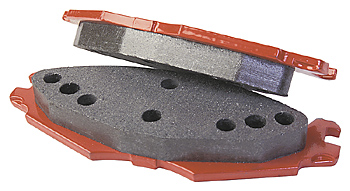
How to Replace Brake Pads
After removing the caliper and brake pads, take a look at the rotor, to see if it’s damaged. If the rotor looks scratched up, take it to a brake service technician and ask if it needs to be replaced. Sometimes, rotors can be salvaged by turning it on a lathe to remove the scuffed up surface.
Step 4
Push back the piston to its original position, using a channel lock or some other device to get a good grip on it, before applying new brake pads. Put the rotor back on.
Apply a bit of brake pad grease to the back side of the brake pads. Don’t apply grease to the front, because that gets in the way of braking. Brake pads are attached to the caliper via a series of clips.
Break Pad Replacement Tips
As you perform your repairs, leave one front brake assembly intact, to refer back to, if you get confused. After you get the pads attached, slide the brake assembly back to its original state. Replace any other loose components in the reverse order of how you took them apart. Repeat on the other side.
Note that when buying new brake pads, rotors and such, it’s a good idea to bring your old ones in with you, so the salesperson can verify that the parts you purchased are compatible with your vehicle.
Always refer to instructions and defer to the information contained in them, if there are steps that conflict with those already outlined. Furthermore, when you’re still learning how to replace brake pads, always have your work inspected by a certified mechanic prior to driving the car. This helps avoid potential injury or property damage.
How to Replace Brakes
If you are an amateur mechanic, learning how to replace brakes yourself is a way to save money on automotive repair. People wear out brakes quicker than ever today, given the amount of commuting we do and the less sturdy engineering that goes into car production. Good brakes are essential to the safety of your car, because you don’t want you brake system faltering in the middle of rush hour.
Once again, this is a job you can do at home, if you’re mechanically-inclined. If you don’t enjoy your own auto repairs or you aren’t a skilled mechanic, take your vehicle into a shop to have your brakes serviced by a professional. If you do choose to make your own repairs, purchase an official automotive repair guide, with specific repair instructions for the particular make, model and year of your vehicle.
The information in this article presents a broad overview of the brake service procedure. It’s not intended to serve as a complete set of instructions, but as brake replacement basics to get you started. What you learn about how to replace brakes in this article won’t replace years of training and experience around cars.
Please consult a mechanic or official automotive repair manual if you have any questions or concerns as this might save your life.
Replacing Brakes
Your average full service brake job includes replacing the brake pads, turning or replacing the rotors, draining the brake fluid and replacing it, while making sure not to leave air bubbles in the lines, inspecting the seals on the wheel cylinders and making sure that the master cylinder is in working order. The following are a set of steps you can follow when replacing brakes.
Step 1
Secure your vehicle on an automotive hoist. Make sure your hoist is squarely underneath and fitted to load-bearing surfaces of your vehicle. Using a torque wrench or tire iron, remove the lugs on either the front or rear wheels.
Remove the wheels from the vehicle using a torque wrench or tire iron. Make sure to leave the opposite brake assembly intact, to serve as a model in case you forget how to put the brakes back together.
Step 2
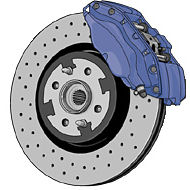
How to Replace Breaks
Inspect the wheel cylinder dust boot, to make sure no fluid is leaking out and the rubber isn’t cracked. Inspect your master cylinder to see if it’s working properly and isn’t leaking fluid.
Remove the caliper from the rotor, so you can replace the brake pads. Loosen the mounting bolts of the caliper in order to release it from the rotor. Inspect your brake hose, to make sure that it doesn’t need to be replaced, as well.
Step 3
Remove the old pads. Clean the caliper slides, pad mounts and anywhere else that directly touches your brakes.
Remove the rotor. Inspect the rotor to see if it needs to be replaced, or if you can salvage it by turning it on a specialized lathe. Clean the surface where the rotor was mounted, to keep the newly-installed parts working smoothly.
Step 4
Depress the caliper piston using a C-clamp, removing the lid of the master cylinder, in case any extra brake fluid needs to be released during the process. After the caliper piston has been depressed, install the new rotor. Put the caliper mount and new brake pads back on.
Replace the caliper. Put the lid back on the master cylinder as well, unless otherwise instructed by your repair manual.
Step 5
Bleed the brake system, to ensure that no air has been trapped in the lines during this procedure. It helps to have a partner assist you, by pumping the pedal for a bit. Have someone hold down the break pedal with their foot, while you bleed the air from the lines.
Refer to your automotive repair manual often, if you’re never replaced brakes on your car before. Don’t drive your vehicle, until pedal functions return to normal.
It’s best to test your new brakes out in an expansive, flat, empty area, in case of brake failure. If your brakes work, you now know how to replace brakes.
How to Replace Shocks
When you feel your car bouncing all over the place as you drive down the road, your shocks have gone bad and you need to know how to replace shocks yourself. Shocks are what make your car ride smooth. You shock absorbers and suspension should be checked about every 12,000 miles or once a year, depending how much you drive.
How to Know When Shocks are Bad
If your shocks have gone bad and you don’t get them checked right away, it can lead to more problems for your car. For instance, when you hit a pothole, if your shock absorbers aren’t working, the shock of that impact is transferred to other parts of your car. This causes damage to vital car parts or engine parts, and often causes pieces of your car to come loose or start working themselves loose.
In the long run, bad shocks cause problems all over your car, from the outer appearance to the inner workings of you engine assembly.
One way to find out if your shocks are going bad is to look at your tires. If you see concave cups on the tires, that means your car is bouncing a lot and riding unevenly. Your shocks need to be replaced.
How to Get Started Replacing Shocks
Before you get start to replace your shocks, make sure you have the correct tools for the job. Here’s a short list of essential tools for when you replace shocks.
- Socket wrench
- Vice grips
- Multiple size wrenches
- Vehicle jack
- Jack stands
- Wheel chuck (if you don’t have a wheel chuck, a big rock or log will make a good replacement)
Before you jack up the car, make sure to place the wheel chucks under the other tires, so the car doesn’t roll away. Place the jack underneath the car. Make sure it’s underneath the frame and not the suspension.
If you place your jack under the wrong spot of your car, you’ll cause damage to the car and jack. Position jack stands underneath the frame for support. Once you have the car hoisted, loosen the lug nuts on the tire and remove it.
Replacing the Rear Shocks

How to Replace Shocks
When replacing the rear shocks, remove the inner covers in the back of your car, to access upper shock mounting nuts. Once you find the mounting nuts, remove them. If they spin, hold them in place with pliers and loosen the nut with a wrench.
Loosen any nuts under the car. If you find any nuts that are rusty or stuck, spray them with some motor oil or penetrating oil, to loosen them.
Remove the mounting nut and washer underneath the vehicle. Next, remove the old shock absorber. If it’s rusty, use a pry bar to get the shock off.
Replacing Shock Absorbers
Compare the new shock to the old and make sure that the grommets and bushings are all in the same place. Once you finish inspecting the shocks, mount the lower end of the shock and tighten the mounting bolts.
Before you cut the retaining strap on the shock, make sure the top is in line. Once the shock is in line, cut the restraining strap and put in any grommets and the shock in place. Put on the upper grommets and mounting nuts.
Put the wheel back on and lower the vehicle. Rock the vehicle a little bit, so the grommets settle into place.
Replacing the Front Shocks
When you replace the front shocks, you need to jack up the car and remove the tires, just like with the rear tires. Unlike replacing the back shocks, when you start to replace front shock absorbers, (before you jack up the car) make sure that there are wheel chucks behind both wheels, so the car doesn’t roll away.
Once again, place the jack under the frame, not the suspension. Use jack stands to support the car. Jack the car up high enough, that you can access the shocks.
Loosen the lower attachment bolts and nuts. Remove them from the shock. Use a wrench to remove the upper attachment nut from the shock absorber, then simply remove the old shock absorber.
Putting the Front Shocks On
Once you have the old shock absorber off, place the first grommet on the shock with the round side up. Slide the rubber bushing down on the shock absorber, until it is seated on the grommet.
Take the second grommet and place it on the shock absorber, with the round side down and slide it into place, until it sits nicely on the bushing. If there is a plastic strip on the shock, remove it.
Place the shock between the upper and lower suspension arms. Push the piston rod of the shock through the upper suspension rod. Tighten the nut, so that it doesn’t fall out.
Compress the shock slowly, until it lines up with the mounting holes on the lower suspension arm. Screw in the nut and bolt and the shock should now be in place. Put the wheel back on and tighten the lug nuts.
Lower the car.
Test the New Shocks
Test drive the car with the new shock absorbers in a safe, open area, to make sure you have properly replaced the shocks. If so, you have learned how to replace shocks.
How to Build a Wooden Boat
Learning how to build a wooden boat sounds like a novel idea, but it takes some work and patience. However, once you have a quality boat made, it can offer you countless possibilities in terms of recreation and relaxation. Wooden boats come in many shapes and forms; they can be used for anything from canoeing to fishing.
Choosing a design with which to build your wooden boat is a matter of personal preference. Some questions you may consider in your search for a wooden boat plan include the following:
- For what purpose will your boat serve?
- How sturdy do you want it to be?
- Do you plan on transporting your boat long distances, or will it stay at a dock close to home? How many people do you want to fit in your boat?
- What experience do you have in terms of boat-making?
- How much time and money do you want to spend?
Wooden boat plans are often archived and/or sold online and can often be purchased in craft supply, hobbyist or construction stores. If it is your first time building any sort of boat or wooden contraption, try building a simple boat first. It also helps if you scale the boat down and build a model first to get a proportional idea of what the finished product will look like.
Materials For a Simple Wooden Boat
Many simple plans for learning how to build a wooden boat only require one piece of plywood, which is economical, stable and flexible for easy construction. Plywood is made from thin slices of timber layered and veneered upon each other.
Plywood is cheap to purchase, but many times cheap-looking. Still, most standard plywood types and grades can withstand pressure and heat. Plywood is a practical option for first-time boat builders and can be purchased in sheets that measure 8 feet by 4 feet.
Some first-timers go even cheaper with exterior-grade plywood, which is considered weaker than other plywood. This might still work well with experimental boat-building. For better-quality plywood boats, consider using Marine plywood as it often must abide by the BS1088 in the United States and United Kingdom.
Epoxy in Boat-Building
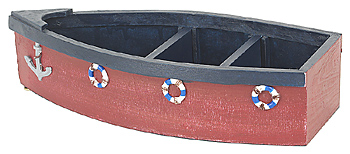
How to Build a Wooden Boat
Purchase epoxy liquid in order to glue your sheets of plywood together when necessary. Epoxy is a standard hardener/glue for average boat constructors and its purpose is two-fold. Epoxy can be used to glue or seal pieces of wood together, but it is also effective in protecting the wood of the boat from absorbing water.
Do not mix different epoxy liquids, because different mixtures could become flammable. Also, it is recommended that you obtain a large polyethylene sheet to place under your plywood pieces during the epoxy gluing process, so that the epoxy does not accidentally glue your boat to the ground.
Make sure you have the appropriate protective gear, such as work gloves and goggles, when you build your boat. Simple hardware essentials, such as an electric saw, a hammer, a few screws, washers and nuts are also needed for boat construction, which may vary between design plans.
You’ll probably need a steel ruler during the lofting procedure, as well as for general measurements for the greatest accuracy.
Building a Simple Wooden Boat
Once you’re ready to begin building a wooden boat, gather your plywood materials and mark the appropriate scales and measurements with a tape measure and/or your steel ruler. Make sure your plywood is both sturdy and, to an extent, flexible.
When you are completely familiar with the set-up of your wooden boat plan and can visualize its construction, sand down rough edges on the plywood and saw the necessary pieces. When you reach the point where you have to join plywood pieces together, place a polyethylene sheet underneath your plywood pieces because it will not stick to the epoxy glue.
One way to secure your plywood boards when you attach them is to use the stitch-and-glue method.
Drilling Holes
Drill a couple of tiny holes near the attaching edges of both pieces of plywood. Stitch the boards together using a copper wire before spreading on the epoxy glue.
After you stitch the boards together in several different places, apply the epoxy glue in the tiny space between the boards. The stitch and the glue will effectively structure and strengthen the bond between the boards. Carefully remove the stitches after the glue has completely dried and fill the drilled holes, covering them with fiberglass tape.
You may then add an additional layer of epoxy glue for extra strength. Repeat these steps with all the necessary plywood pieces you must attach in order to build your wooden boat.
Painting Your Wooden Boat
When you are finished building your wooden boat, you may want to paint it. Allow just short of one week for your boat and the epoxy glue to set completely, before going through with any painting.
The best paints to use for marine plywood include standard marine enamels and epoxy paints. Remember to sand the surface of your boat before applying the paint, so that the paint has a better chance of adhering to the wood permanently.
After you paint a few even coats of paint to your wooden boat, make sure to let it dry for at least a week – especially if you are using epoxy paints. Once you have finished painting and drying your wooden boat, check to make sure you have filled any miscellaneous cracks and imperfections on your boat. Let that dry, and you have successfully learned how to build a wooden boat.
For more details regarding how to build a wooden boat, check out:
How to Build a Trailer
Learning how to build a trailer can save you a lot of money, but you have to know the steps to building a safe carrying platform and hitch. Trailers are a practical way to transport many heavy objects, from bricks to speedboats to hay to pumpkins. You’ll need to build a trailer which can carry loads over long distances, so you’ll want a sturdy construction.
Building a home-made trailer can take some time and effort, but it can result in a durable, handy apparatus for practical use. Common trailers include conventional travel trailers, fifth-wheel trailers and cargo trailers. A few things to consider when building a trailer are choosing the right axle set, frame, suspension, weight capacity and general dimensions for your trailer.
Brainstorming What to Build
Think about the following questions before you begin to learn how to build a trailer:
- What kind of trailer do you desire?
- Would you use your trailer for work or recreation?
- What will it primarily transport?
- Does the build need to be resilient enough to withstand long-distance highway driving?
- Does your automobile have enough power to haul the weight of your trailer in addition to the heavy objects you wish to transport on long distances?
Before you start building a trailer, remember that your automobile needs to be able to climb hills and mountains in order to handle dragging a trailer around.
Building a Trailer Tips
Materials you may need when building a trailer include:
- Good axle kit
- Flat wooden boards
- Iron angle boards
- Crossbar
- Latch
- Ball mount
- Coupler
- Spring hinges
- Security chains

How to Build a Trailer
Drawing out a plan for your trailer is often necessary to build a sturdy trailer.
Saw your wooden boards for the main body of the trailer. Make sure that your cuts are precise and squared so that when you lay your boards side-by-side, there are no gaps or severe inconsistencies in your sawing. Wield the various parts of your main frame before you attach the axle or hitch.
Also, make sure you use some type of protecting agent on the main body if it is built of wood in order to shield it from weather damage during use.
Iron Angle Boards
When building pieces for the back of your trailer, you may want to use iron angle boards for a sturdy build. Wield the iron pieces together.
You may choose to create a trailer out of an old Ford or Chevy vehicle. You may also choose to buy the main body of a trailer and install the axle and other accessory parts by yourself. In that case, you would be investing anywhere between $400 to $1500.
If you plan on transporting a boat around, a galvanized or aluminum trailer may be your best bet, especially if you want to store your boat and/or trailer by salt water.
Installing the Axle to the Trailer
It is fundamental that you measure and position the axle on your trailer, double-checking your measurements. Your axles will be positioned on different spots on your trailer, depending on the type of trailer you wish to build. For example, a tilting trailer would require that you position the axle so it is near the gravity center of the apparatus.
The most important thing about axle installation is that you need to center it in relation to the frame of your trailer. Make sure you align your axle with the center of the frame; otherwise, your trailer will drag slightly sideways on the road, which puts unnecessary stress on your towing automobile and can damage the tires on your trailer.
Do not neglect the fact that the axle must be squared and centered on the main frame of your trailer. The distance of the wheels to the hitch must also be equal for the trailer to maintain proper balance.
Ensuring the Safety of Your Trailer
Your main concern with building a trailer should be that it follows safety guidelines on the road. The California Department of Motor Vehicles offers a few tips on towing your trailer safely on the road.
Before you use your trailer, make sure that your ball mount and receiver mechanism is stable and intact, your spring bar hinges are stable, your hitch coupler is locked down, your safety chains are attached and secured and your electrical plug is working properly (if applicable).
How to Build Your Own Trailer
Building a trailer can be an exciting venture that will serve very practical uses for a long time. A quality trailer can last more than 15 years if built appropriately. You may need to replace the hinges and axles occasionally, but a quality main frame and body will last for much longer.
Homemade trailers take some time, money and effort to build, but it’s possible that long term use outweighs the costs and learning how to build a trailer can offset the costs of purchasing a new one.
Further Reading on How to Build a Trailer
How to Build a Raft
Rafts are possibly the most basic form of flotation craft. Building a raft offers simplicity in both production and practical use. From a few pieces of driftwood fastened together to a bundle of gathered logs from nearby trees, many things can qualify as a raft.
For those who are into survivalist hobbies or who simply want to learn what to do in one of those worst case scenarios, learning how to build a raft building can be a worthwhile pursuit. Building rafts can also be a fun summertime activity for beach outings and camping.
This article will show you how to build a raft by breaking down the process into three parts: materials, steps and building tips. While building a raft can seem daunting and physically demanding, it can be a fun and relatively painless project, if you plan out your course of action adequately and obtain the right tools and materials.
You aren’t reading this article from a deserted island, so you have the convenience of being able to purchase items, take your time and pick the right materials, redo bad work, and experiment with different design ideas. Once you learn how to build a raft in a structured situation, you’ll know the techniques for building rafts when it all goes down.
Planning Stage – Building a Raft Materials
Decide what materials are necessary for building the raft. Get an idea of the design parameters for the raft and compile a list of steps that will be executed to actually construct the raft we want.
To start, here is a list of things you will need to construct the raft. This list is by no means the end-all raft supply list, and due to the nature of raft building, you may be fine using the things around you as substitutions for some items and tools as necessity dictates.
You can also add your own ideas to the design to improve upon the raft for your specific requirements. Here are the materials:
- A hand axe
- ½ dozen 12 ft. logs and at least 12” across
- 2 small logs about 7 ft long and 6” across
- Rope or twine – In dire circumstances: dried fibrous seaweed, bark or a similar material will do.
These things will get you on your way to building a very simple raft. If you want to get more advanced, such as building a raft with a sail, you can always acquire additional logs and some sort of large cloth or tarp to use as a sail and add it to our basic design.
For now, we will focus on the most primitive type of raft, which is also the easiest to design and create.
Planning Stage – Raft Building Design & Steps

How to Build a Raft
To get an idea of the actual design of our raft, you will simply have to imagine the type of prototypical raft often seen in survival programs in movies or television. This raft is constructed of six long parallel logs underpinned by the two smaller logs and bound together with twine.
When finished, the raft should be rectangular in shape and as solid as possible with few gaps between the logs if any.
The planning stage is instrumental to constructing your raft the right way. Making a list and committing yourself to following it will help keep you focused during the construction process. We will break the constructions process into different phases:
- Preparatory phase – Gather all of your materials in one place and align all of them to be worked with.
- Cutting – In the cutting stage, you make all of the notches in your wood in order to make the logs fit together.
- Hitching – When hitching, you are basically securing all of the logs together and ensuring the maximum structural integrity for your future seafaring vessel.
Building Phase – How to Build a Raft
Actual construction shouldn’t be too difficult, though there are some things to take into consideration. When in the first phase, try to find a formation for the logs that places them as tightly adjoining as possible. This may entail rolling the logs so they are flush or scraping knots and curved spots so they can lie flat against another log.
For the second phase, the cutting phase, you will want to make all of your notches about 2” deep and wider at the bottom than at the top. After each of the 6 logs has a notch at each end, you can slide the two shorter logs into the slots to stabilize the entire craft. Since you made the notches smaller at the top, the logs will want to stay in and not fall out.
Finally, for phase three, you can never use too much rope or too many knots. Securing the logs not only lengthwise but also in diagonal rope patterns is advised. Basically, you want the logs pushed together from all angles to ensure the most structural stability.
Learning how to build a raft is fairly easy but can be time consuming. It would be good to make this project a family affair as it can be fun as well as educational.
For more raft building instructions, we recommend:
How to Make a Hovercraft
Learning how to make a hovercraft sounds like a tough task. You might think building a hover vehicle sounds like something impossible, entirely out of science fiction. Those people may be wondering, “What the heck is a hovercraft?”
Hovercrafts are fun, inexpensive, low-flying disks or rafts that you can sit on and hover over a small area. Hovercrafts take many shapes and forms, but one thing they all have in common is the fact that they are air cushion vehicles (ACV) and ground-effect machines (GEM) – that is, they hover over the ground on a cushion of air.
One distinguishing feature of hover vehicles is they do not have wheels.
Making a Hovercraft
Building a basic hovercraft is easy and inexpensive, but hover devices break easily and look cumbersome. Many high school or even college students build simple hovercrafts as part of their physics curriculum or science fair projects.
However, building a quality hovercraft that can fly for a considerable amount of time can take much more money, patience and skill. Although the craft of building a Hovercraft is not difficult with the right tools, dimensions and power sources, you need to prepare for much trial and error.
How a Hovercraft Works
A hovercraft can move over any type of ground, water or other surface without too much trouble, because a hovercraft never touches the ground during standard operation. In a more complex hovercraft, an axial lift fan creates pressure and forces the hovercraft to trap a cushion of air in a chamber underneath the vehicle. A hovercraft skirt contains the air chamber, which operates between the belly of the vehicle and the ground it hovers over.
Air jets are installed on the sides of the hovercraft and blow air at a 45 degree angle in order to create pressure and lift. Modern hovercrafts include bag skirts and finger skirts that control the air pressure, stability and smoothness of the vehicle’s operation.
Plans for Your Hovercraft
If you are not sure how to make a hovercraft, consider buying or researching a hovercraft plan. For a basic home-made hovercraft, one professor at the University of Minnesota puts out a great step-by-step plan called the Human Hockey Puck.
Otherwise, if you are looking for a more professional design, Hovercraft dot com offers plans for hovercrafts that can seat one to more than ten people. In addition to hovercraft plans, the Hovercraft website also sells quality hovercraft parts and engines for the enthusiast.
How to Build a Hovercraft
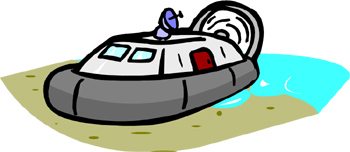
How to Build a Hovercraft
Knowing how to build a hovercraft doesn’t have to be complex. Building a simple hovercraft involves two 48-inch diameter plywood discs, a vacuum cleaner, stool, nuts and washers, screws, a small wood block with a hole to attach the hose of a vacuum and a coffee can lid.
The top disc will serve as the top of your hovercraft on which a stool is attached so you can ride it. The hose of your home vacuum is attached near on a hole on top of your first plywood disk to supply the air pressure that will lift your hovercraft above the ground.
The bottom (2nd) plywood disc should be punctured with 12 1-inch air holes in 2 rows around the coffee can lidded center of the disc to enable the air from the vacuum to seep into an air chamber which will help lift you from the ground. The bottom of the 2nd disc should also be covered with thick plastic and stapled to the edges of the board so the air from the vacuum form the skirt pressure chamber that will make the hovercraft float.
Engines for Your Hovercraft
If you are looking to build a more complex, sturdier hovercraft, consider investing in a more powerful engine. Depending on what Hovercraft type and quality you are planning on achieving, you will need different engines.
For example, an engine for a basic hovercraft can consist of anything from a household vacuum to a simple leaf blower. However, a quality hovercraft that can fly outside without cumbersome vacuum cords on the ground requires anywhere between a 5 and 35 Horsepower engine.
Tecumseh builds a quality 5 Horsepower engine that is less than $200, which will serve a hovercraft which is built for simple recreational use. The Briggs 20 horsepower engine, which is priced at a little over $700, is considered a popular, reliable mid-range engine. Briggs also offers a 35 Horsepower engine for the wealthy enthusiast – it is priced at over $2200.
Whatever your preferred engine type and building plans, this Hovercraft Kit page and this article at Discover Hover are good resources, if you want to know the realities of building a hovercraft as well the practical and recreational uses for it.
Steering your Hovercraft
Installing movable rudders and a thrust propeller on the underside of your hovercraft will give a hovercraft more momentum and steering capabilities. Attaching a handlebar or joystick will give you full control of the rudders, in order to steer your hovercraft. Horizontal wings on your hovercraft play the role of a flight trim system, which enables the hovercraft driver to steer the hovercraft above ground.
Variations in the surface over which you drive your hovercraft will determine the speed of your vehicle at any given time. For example, tall grasses or high waves on the water will create a skirt drag and spray drag, which will slow down your vehicle.
When steering your vehicle, make sure you make turns well ahead of the actual turn. Use caution when turning a hovercraft because it uses a high turn radius.
Learning how to make a hovercraft can be a fun activity for families and students. Cheap, home-made hovercrafts take less time to build than complex hovercrafts but quality hovercrafts last longer and are safer to ride. The appeal to building a hovercraft is the fact that you are building an apparatus that will enable you to float over the ground.
How to Build a Hotrod
It seems that, since the invention of the internal combustion engine, America has been in love with speed and learning how to build a hotrod is a great way to satisfy that love. Nothing embodies that love better than the image of a classic hotrod, racing down the open road or around the racetrack.
Many Americans dream of one day build their own hotrod so that they can customize it to meet their exact wants and needs. For the adept mechanic, building hotrods from scratch can be a cheaper and more rewarding way of acquiring the cars of their dreams rather than having to settle for a pre-manufactured model.
Building Your Own Hotrod
In order to build your own hotrod, you should be a competent mechanic. If not, at least know one with whom you can direct your questions or request assistance from time to time. Remember that, before you begin a project like building a hotrod, the rewards don’t come overnight, and nothing ever goes as planned.
Be prepared to do some serious lateral thinking to get around the obstacles that are sure to come your way. It is important to note that the information presented in this article is not meant to replace the knowledge of a certified mechanic and an automotive repair manual.
What Type of Hotrod Should I Build?
Before rushing out and buying parts for your dream hotrod, take some time to decide what type of hotrod you want to build. Look at pictures on the Internet or consult your local library. After deciding on what type you want to build, find a large, covered area where you can work on your vehicle and keep it out of the elements.
Also, make sure that you have all the required tools which will be listed in hotrod assembly books. A mechanic could give you a good idea of what you’ll need.
Step 1 – Find a Hotrod Frame
As your first step in learning how to build a hotrod, scour local junkyards or classic automotive supply centers for a straight, reasonably rust free frame that matches your desired hot rod type.
Procure front and rear axles that are in good shape. The rear axle can be a little wider than the body if that is the look you are going for. Look for a good set of leaf springs for the rear axle. Assemble it according to the instructions in your automotive manual.
Your front axle should be straight suspension if you are a purist but independent suspension allows the car to handle better.
Step 2 – Make Your Own Frame
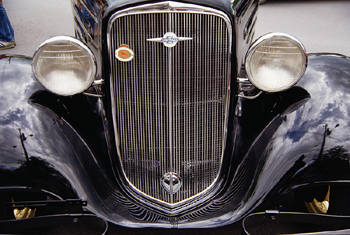
How to Build a Hotrod
Find a body for your hotrod. You can hunt for old hotrod bodies that are still in good condition, make your own out of steel or fiberglass or customize a pedestrian car body into the form of a hot rod.
It is important to be handy with a welding torch because a crude welding job on the body will kill the aesthetics of your hotrod.
Step 3 – Find an Engine, Transmission & Driveshaft
Start picking out an engine, transmission and driveshaft. You should make sure that the engine you purchase is in good running condition and doesn’t break the bank. Also, remember what transmission you are going to use so you don’t buy an engine so big that it is too much for the other drive train components to handle.
Some other considerations are whether or not you would like an authentic to the rest of your hotrod. For example, you wouldn’t put a Dodge motor in an old Ford. Mount your engine and install the transmission and drive shaft according to your automotive manual’s instructions.
If you have any concerns, consult a mechanic. This is not stage in your hotrod building process that you can wing it and not have negative repercussions.
Step 4 – Assemble Smaller Parts
Assemble your gas pedal linkage, brakes, steering, cooling system, seat belts and interior. When allocating your budget for these types of things, spend your money on the important stuff first even if it is less fun to get a quality brake system than some great leather seats that everyone will notice.
Also, install your gauges, wirings and other things of that nature which will make your hotrod street legal.
Step 5 – Full Assembly is Required
Make sure everything is in working order and assembled correctly. Check the engine for leaks; make sure the gas, brakes and steering work. It is a good idea to do this somewhere deserted and open so that if something does go wrong, nobody gets hurt.
After everything is in working order and checked out by a certified mechanic for safety’s sake, you should have completed the task of discovering how to build a hotrod.
How to Build a Bike
Read how to build a bike, whether you’re an experienced cyclist looking to customize a bike or you’re a curious beginner who want to build a bike as a way of getting better acquainted with how a bicycle works. Learning how to build a bike from parts is a fun, yet challenging, task.
Doing so yields a sense of satisfaction that cannot be obtained from simply purchasing a bike off the rack. Before riding your newly assembled custom built bicycle, make sure to take it into a specialty bike store to be examined to make sure that everything is where it should be and in working order.
Furthermore, official manufacturer’s guidebooks provide much more thorough instructions regarding the specific parts you are using, as well as how to assemble a bicycle. It is advisable for you to consult resources such as these prior to beginning your project.
Bicycle Parts
After you have decided what type of bike fits your needs, head down to your local specialty bike store in search of parts, or to procure bicycle parts from a catalog or online. Your local specialist might provide you with a more limited array of available parts.
Specialists, however, will often be willing to dispense valuable advice that will help you along the way. Before you learn how to build a bike, you will need to purchase the following items:
- A bike frame. It does not have to be brand new, but it must be in excellent condition.
- A component kit. This kit contains a variety of vital components that allow your bike to work. You must buy a brand new kit to avoid catastrophe which can be brought about by purchasing damaged or defective components. Many bike manufacturers produce these kits, which contain things such as your derailleurs, shifters, chain and brake set.
- Wheels. Don’t skimp on these because they are very important and cheap ones will make riding your new bike a chore. Furthermore, when selecting wheels, make sure that they are compatible with your component kit. Consult a bike specialist for details.
- Tires and Tubes. The tire makes more of a difference than the tubes so allocate your finances accordingly. When purchasing tires, keep in mind what you want to get out of your bike. Don’t buy mountain biking tires for your beach cruiser.
- Handle bars. Check out a wide variety of styles that fit your riding needs before making a final selection as you will have to grip these every time you are riding and they can get uncomfortable quickly if you buy ones that don’t fit you well.
- Seat and seat post. Make sure that the seat you select fits your riding needs as well as your body type. It is common to develop saddle soreness when riding and a good pair of bicycle shorts can help alleviate this.
- Pedals. There is a wide variety to choose from and, in the end, you get what you pay for so make sure that you like the set you are buying.
For road bikes, a good idea is to purchase pedals that allow you to lock your foot to them via specialized bike shoes on one side while the other side of the pedal accommodates street shoes. Consult your local parts dealer for more information.
How to Assemble a Bike

How to Build a Bike
The following 5 steps will guide you through the process of how to assemble a bike.
Step 1: Assemble Your Tools
Assemble your tools, which include a variety of common household tools like screwdrivers as well as more specialized tools which include a pedal wrench, Allen wrenches, chain cutter, chain whip, bike stand, chain breaker, bottom bracket tool, crank puller, cassette locking tool, cable cutter and cable locking tool.
Step 2: Tires and Seats
Put the tires and tubes on the wheels while lightly greasing and assembling the cassette. Following this, affix the seat and seat post to the frame.
Step 3: Handle Bars and Steering Tube
Affix your handlebars, stem and steering tube together, which are then attached to the fork of the bike. Following this, attach the shifters to the handlebars. This will require Allen wrench.
Step 4: Gear Shifts & Breaks
Add the gear shifts to the handles of the bike and then affix the brakes to the frame, taking care to properly attach both the front and rear brake kits. Following this, attach the crank set, and the derailleur cables to the bike. This will require specialized tools such as a bottom bracket wrench.
Step 5: Bike Chain
Measure your bike chain and cut it at the appropriate length. Assemble it following the manufacturer’s instructions. Once this is done, install the brake and derailleur cables. Given that this is a difficult procedure, consult a bike technician for a more thorough explanation.
After this is done, take your bike to a specialty shop for examination and have the tech assist you in making sure that everything is dialed in, assembled correctly and fitted to your body type. Although you may have learned how to build a bike yourself, a professional should view your work to avoid injury.
Many bicycle assemblers get frustrated the first time they try to thread a bicycle chain. Be prepared to be patient and, remember, this gets easier, each time you assemble a bike.
How to Build an Electric Car
Learning how to build an electric car is enlightening, because you begin to see how electric-powered cars could be mass-produced. Creating a vehicle that runs on batteries is more fuel-efficient, though building your own personal battery-powered car is going to be involved. Building an electric car takes a lot of time and money during the initial stages, but it saves you gas money in the long run.
It’s also a fun project for car enthusiasts, if they have any kind of talent for engineering. Building a car from scratch is a way to really get to know the unabridged details of car-building.
The Electric Vehicle Photo Album (http://evalbum.com) gives you a good idea of the variety of cars you can turn into an electric vehicle. From the squish-worthy Global Electric Motorcars to futuristic Electricycles to electrically converted Corvettes, there’s an array of options you can mull over, if you decide to build an electric car. It is beneficial for you to consult a local mechanic or technician for more guidance on the fine details of electric car construction and operation.
Converting a Car
The main two considerations when choosing a car to convert into an electric car are carrying capacity and weight. Don’t consider transforming a junk car, just because it’s cheap. Cars over ten years old are difficult to convert, not only because they could still retain many of their operational problems after conversion, but also because unique parts for those cars may not be available anymore.
There is really no best car to work with converting, because each car has its own strengths and weaknesses. Building an electric car is solely reliant on the driver’s own preferences, though there are some factors you’ll need to consider. While there may not be one perfect car model to use, there are a number of cars that you should never convert into a electric-powered car, based on a bad ratio of carrying capacity and weight.
Motors and Batteries for Your Electric Car
Motor selection for building your electric car is the most significant choice you make during the building process. Many electric car enthusiasts swear by the serious wound DC motors, while more conservative builders still use General Electric, Baldor and Prestolite motors. Many car parts supplies in the modern day sell Warp and Advanced DC lines of motors.
Some people consider using forklift or golf cart motors. These motors are often either too heavy or too small to work electric cars. The type of motor you choose for your electric car depends on the size and weight of your car and how much power you need to run it, so a motor fit for a golf cart isn’t going to work for a standard size automobile.
Electric Car Battery Types
There are four types of batteries usually installed in electric cars: flooded lead acid batteries, Vale Regulated Lead Acid batteries, gell cell batters, nickel-cadmium batteries and lithium-based batteries. These four types of batteries have limitations and need more development, at present. However, since they are the only options out there, people wanting electric power have found ways to make them work.
Flooded Lead Acid Batteries
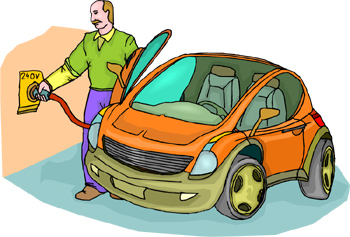
How to Build an Electric Car
Flooded lead acid batteries are the same ones used on golf carts. This battery type saves you money in the long run, but you have to make sure you keep up with the batteries’ water levels and cleaning maintenance. A slight disadvantage of the flooded lead acid batteries is they can’t power cars that carry too much weight.
In addition, if your electric vehicle exceeds 600 amps in current loads, the flooded lead acid batteries losing significant service life. You’ll end up replacing them too often to make them optimal.
Valve Regulated Lead Acid Batteries
Valve Regulated Lead Acid batteries are the same kind of battery that powering your laptop computer backup power systems. Although they don’t require the water level and cleaning maintenance of the Flooded lead acid batteries, they cost more and have less service life to begin with. Also, valve-regulated batteries need a complex charging system.
More Electric Car Batteries
Gell cell batteries, nickel-cadmium batteries and lithium batteries tend to be on the pricier side, but they afford you much longer service lives than either the Valve Regulated Lead Acid or flooded acid batteries.
Nickel-cadmium batteries last for a long period of time and are worth the money you invest. Lithium batteries have yet to develop to their full potential but they seem to deliver a higher service life than many other types of batteries. Nickel-metal and zinc-air batteries both have promising potential for the future of powering electric vehicles but they are currently not available for sale to the general public.
Resources for Building Electric Cars
EV Web Links is a comprehensive web page detailing quality parts suppliers, electric vehicle photo albums, electric vehicle testing sites, newsletters and other electric vehicle resources.
C & D Technologies and Everspring Global Limited are good sites to start shopping for a battery for your electric car. Various regional electric vehicle councils and associations, such as the Australian Electric Vehicle Association, the Electric Auto Association, and the Honda EV + Electric Vehicle Drivers are resources for your questions on electric car building specifics. You can also find deals on electric parts at any of these websites.
However you choose to build an electric car, read about the process and have the basic concepts down, before you begin to collect the parts needed for an electric car. Look at your project as an journey of discovery. Building electric cars may seem like a daunting project for a novice, but plenty of resources are available online to help you get on your way.
Electric cars are not only useful for short distance driving, but are also a safe option for the environment. Learning how to build an electric car yourself should make you more informed about the science of electric car engineering, while your electric car shows your friends, family and neighbors that electric cars aren’t just some happy dream of the idealists and visionaries of the world.
How to Paint a Golf Cart
Learning how to paint a golf cart gives might not give back the respect you lost, if you keep losing on the links, but it can restore your golf cart to its original beauty. Maybe you want your golf cart to stand out among the dozens of other cluttering the fairways.
Give your golf cart an upgrade isn’t too difficult of a task. While you might think painting a vehicle is better done by a pro, painting your own golf cart yourself has its advantages.
Painting your course transportation yourself means avoiding the hassle of having the job to your exact specifications. By doing it yourself, you’ll complete the project on your own schedule and make sure the golf cart looks exactly as it should.
Painting Golf Carts – Preparation
The importance of preparation in painting golf carts can’t be overemphasized. Set up a tent or some sort of area that’s protected, if you do not want to paint in a garage.
- To begin, strip all of the trim from the vehicle. This includes any trim and bumpers, if necessary.
- Clean the golf cart from top to bottom, removing any dirt and grime.
- Next, apply wax and grease remover to the body of the golf cart.
- Apply duct tape to the edges of the front window to keep it from becoming scratched.
- Sand down the old paint. Reduce the golf cart to its original primer or factory paint before applying your own primer and paint. Try using a dual-action air sander for best results.
- Patch up any rust areas as you come across them before you go any further. This shouldn’t apply to most golf carts, since newer carts are made with synthetic plastic materials.
- Cut out the rusted area, if possible and clean the exposed area thoroughly before applying a patch. Use a body filler for any minor flaws or dents on the surface of the golf cart.
- Use a plastic spreader to apply filler evenly over the surface. Smooth the top with a knife when the filler is almost hardened and cut out any excess filler.
- Use acrylic glazing compound over the section covered by the filler to give it a smooth, professional looking surface. Skipping this step could result in tiny bubbles forming overtop the filler.
- Sand down the glaze.
Masking the Vehicle

How to Paint a Golf Cart
You may want to mask any areas on the body of the golf cart, particularly if painting a special decal or logo. Use soft-edged foam tape, so as not to damage the vehicle. Masking the entire golf cart is the next step, and an extremely important one at that.
Before you even being to paint a golf cart, be sure to purchase specialized auto masking tape and paper. Set up a curtain or series of sheets or towels all around the golf cart on the underside, to avoid getting paint on the underside of the golf cart.
Mask off the floor or grass, depending on where you are doing the painting.
Priming and Painting the Golf Cart
Before applying the actual paint, lay down a layer of primer. If you have a type of primer you prefer to use, stick with that.
If not, use an epoxy primer to seal to the vehicle. Apply a contrasting color on top of the primer in order to achieve the best results.
This will serve as a reference during the sanding process. Sanding down the color is easier than the primer itself, since you’ll better be able to see uneven areas.
This guide coat should only be misted over the vehicle, not painted directly on. Sand the primer using coarse paper.
Apply a Second Coat of Primer
If all imperfections are taken care of, apply a second coat of primer. Add two coats, so the sanding does not break through to the layer beneath the primer. After waiting for the last coat to dry, remove the masking surrounding the golf cart.
Wash any accumulated grit from the surface of the vehicle and wet-sand it until smooth. Before the base coat of paint is applied, dust the golf cart off with dry paper towels.
Apply a Base Coat of Paint
Apply the base coat, which should go on lightly. Use a spray gun and aim it perpendicular to the area you’re spraying. Hold the gun about a foot away from the surface.
Allow the base coat sufficient time to dry before adding the secondary coat. Let the paint settle before a final sanding and buffing. Finally, remove the masking and reattach the items you removed in the first step.
Painting a Golf Cart – Tips for the Entire Process
Here are some tips and guidelines to remember throughout learning how to paint a golf cart:
- When applying acrylic glazing compound, use only a small amount at first. The material takes a long time to dry and shrinks if applied too generously.
- Spend too much time on the job, instead of not enough time. A paint job isn’t something you rush through. For example, make sure you wait for the paint to dry before adding another coat.
- Consider laying down a double coat of masking tape in case the tape has any small holes or tears.
- When dusting the golf cart, use paper towels instead of rags. Rags contain traces of fabric softener, which don’t interact well with most types of paint.
- Ensure your working environment has proper air ventilation to avoid inhaling fumes.
How to Paint a Car Interior
One way to spice up an old car is to paint the car’s interior. Doing so requires some research, because nobody should attempt to paint their care without having a good handle on how to paint a car interior. Remember, this is the part of your automobile that people are going to sit in and have time to examine, so any flaw is likely to stand out doubly-so.
Why Paint a Car Interior?
At the same time, painting the interior of a car gives new character, freshness and pizzazz to your vehicle. With a few household items and inexpensive materials, you can paint the interior of your car. Unlike most painting jobs, painting the interior of your car is a fairly quick and easy process, especially with the spray paints available today in service shops or online.
Painting your car’s interior could help your car achieve a brand-new, clean look with minimal mess or trouble. Learning how to paint a car interior yourself is a heck of a lot cheaper than paying a car shop to do the same thing. There are a lot of options to choose from when you consider painting a car interior, though, which can be stifling.
Which Paint Do I Paint My Car Interior With?
Take note that appropriate paints exist for plastic, vinyl and leather car interiors. There are even ways to recolor your seats and carpeted car ceilings. Make sure you understand the kinds of material that adorn your car interior, so that you can choose the corresponding paints to use.
Getting Ready to Paint Your Car Interior
The first step to take before you can paint your car interior is to cover your car’s seats with protective plastic sheets. Recolor your seats last in a painting job, to protect them from the paints you use on the main dashboard. Remove any miscellaneous items or accessories that might get in the way of your painting job.
Painting a Dashboard
If you plan on painting the dashboard, you need to remove as many knobs, buttons, trays and dials as possible. Wash these car parts gently with soap and water. Dry them thoroughly.
Many people prefer using a blow dryer to get into the small cracks and kinks of knobs and buttons. Whatever you choose, place them aside after you have dried them.
Go back into your car and wipe and/or scrub your dashboard with a rag of gentle soap and water. Make sure to scrub out the stains. Clear protecting agents that seal your dashboard and prevent paints from adhering to it.
Wipe the soapy substance out with a wet rag and dry the dashboard thoroughly with a clean, dry rag.
Interior of Your Automobile

How to Paint Car Interior
While your dashboard continues to dry, use painter’s masking tape, which is thin and blue, to seal the edges of your car interior. This ensures the painting job is a neat one.
Apply painter’s masking tape to items on your dashboard that you do not want painted. These items include your radio and vents, among other things. Use sand paper over the hard plastic surfaces of your dashboard, since this makes it easier for the paint to adhere to it.
Wipe the dust with a wet rag. Clean your dashboard and its respective knobs, buttons and other separate pieces again with some rubbing alcohol.
Painting Your Car Interior
In learning how to paint a car interior, begin your painting job with a quality primer. PG epoxy primers called DP are a good fit for most car interiors, since they last for a long time and don’t emit as many hazardous fumes as other primers do.
Don’t take this to mean you shouldn’t wear protective gear while priming/painting your car, because you should always wear a face mask, goggles and sometimes gloves to protect yourself from the harmful chemicals within paints and primers. Keep the car windows rolled down during the painting process, to increase ventilation in the car.
Applying Primer to the Interior
Apply the primer to your car in thin coats. Allow the primer to dry completely before you actually paint the interior of your car. When you choose paints for your car interior, try to find one that is least toxic, especially because interior car paints emit hazardous fumes even after they dry.
For instance, if you’re driving your car one day and it’s hot outside, the heat can cause the paint to emit toxic fumes.
Applying the Paint
Apply two even coats to the interior of your car, so that the paint has a better chance of adhering and lasting permanently. Don’t forget to carefully paint your separate knobs and buttons, before installing them back into your car’s interior. Wait for at least 24 hours, which gives the paint time to dry completely, before doing anything more.
Choose to recolor the seats or fabric ceiling of your car, after the rest of your car is painted and dried. To do this, buy an upholstery spray at any auto shop and apply it carefully to your seats and other fabric parts. Make sure to wait for your seats to dry completely, before driving your car. Drying your seats may take a bit longer than drying the paint on your dashboard.
Painting your car interior doesn’t take more than a couple of days. This gives your car a fresh new feel. Many different car paints are available and easy to use, even if you don’t consider yourself a good painter.
This might sound like a lot of trouble to paint the inside of your car, but you have to offset this against the time spent making money to pay a body shop to do the same thing. Educating yourself on how to paint a car interior, rather than taking it to the shop, can also save you a lot of money and takes little skill.
How to Paint a Car
If you need to paint your car, consider learning how to paint a car yourself. This is cheaper than paying a car shop to paint your car, and you know exactly how you want the automobile painted. Doing it yourself means avoiding the hassle of making sure someone else does the job to your exact specifications.
While painting a vehicle might seem like a job better left to the professionals, learning how to paint a car yourself has several advantages, besides the ones pointed out above. By painting the car yourself, you complete the project on your own schedule and make sure the car looks exactly as it should. It bears repeating: you also end up save a lot of money.
On the downside, studying how to paint a car and then taking the extraordinary step of painting a vehicle takes a lot of time. With a full time job, you’ll end up spending a lot of time away from the wife and kids at night and on the weekend. If you have no kids or they enjoy spending time around cars, this might not be a problem for you at all.
Car Painting Instructions – Preparation
The importance of preparation when learning how to paint a car cannot be overemphasized. Several hours of work are required before any painting can actually begin.
Our car painting instructions begin with removing the paint. First, strip all of the trim from the vehicle. When I say “trim”, that includes the grill, both bumpers, side view mirrors and license plates.
Next, clean the auto from top to bottom, removing any dirt and grime. Apply wax and grease remover to the body of the car. Apply duct tape to the edges of all windows to keep them clean, in preparation for the next step.
Sand the Paint from the Car
Sand down the old paint. In short, you will need to reduce the car to its original primer or factory paint, before applying your own primer and paint. Try using a dual-action air sander for best results.
If you come across any rust areas, patch them up before you go any further. Cut out the rusted area, if possible. Clean the exposed area thoroughly before applying a patch.
For minor flaws on the surface of the car, use a body filler. Use a plastic spreader to apply filler evenly over the surface. When the filler is almost hardened, smooth the top with a knife and cut out any excess filler.
Use acrylic glazing compound over the section covered by the filler to give it a smooth, professional looking surface. Skipping this step could result in tiny bubbles forming over the top of the filler. The final step in sanding your card is to sand down the glaze.
Masking the Vehicle
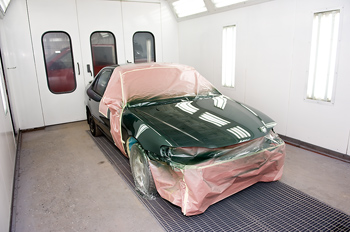
How to Paint a Car
In the event you want to mask any areas on the body of the car, consider using a type of soft-edged foam tape that won’t damage the vehicle. Areas of concern to focus on include those where you’re painting a special design such as racing stripes.
Masking the entire car is the next step. I can’t emphasize enough; this is an extremely important step. Masking can take up to eight hours, but it must be done properly. Place plastic over the windows of the car and secure this plastic with your masking tape.
Be sure to purchase specialized auto masking tape and paper. To avoid getting paint on the underside of the car, set up a curtain or series of sheets or towels all around the car on the underside.
Priming and Painting the Car
Before applying the paint, lay down a layer of primer. If you have a type of primer you prefer to use, stick with that. Otherwise, consider using an epoxy primer, because it seals tightly to the vehicle.
Apply a contrasting color over the top of the primer in order to achieve the best results. This will serve as a reference during the sanding process. Since sanding down the color is easier than the primer itself, you should be able to see any uneven areas.
This “guide coat” should only be misted over the vehicle, not painted directly on. Sand the primer using coarse paper.
Apply a second coat of primer, if all imperfections are taken care of. It may be necessary to add two coats, so that the sanding doesn’t break through to the layer beneath the primer. Remove the masking surrounding the car after waiting for the last coat to dry. Wash any accumulated grit from the surface of the vehicle. Wet-sand it until smooth.
Before the base coat of paint can be applied, dust the car off with dry rags.
Apply the Base Coat of Paint
Apply the base coat, which should go on lightly. Use a spray gun and aim it perpendicular to the area you are spraying, holding the gun about a foot away from the surface. Allow it sufficient time to dry before adding the secondary coat. Let the paint settle for 48 hours, before any final sanding and buffing.
Car Painting Tips
Here are some car painting tips and guidelines to remember when learning how to paint a car:
- When applying acrylic glazing compound, use only a small amount at first. The material takes a long time to dry and can shrink if applied in too large of a quantity.
- If you’re going to do one or the other, take too much time, as opposed to too little, in completing this project. For example, make sure you wait for the paint to dry before adding another coat.
- Consider laying down a double coat of masking tape in case the tape has any small holes or tears.
- Ensure your working environment has proper air ventilation to avoid inhaling fumes.
Further Reading on How to Paint a Car
- How To Paint A Car
- How To Paint A Car
- How to Paint a Car
- How to Paint a Car
- How to Paint a Car
- How to Paint Your Car
- How to Paint a Car
- How to Paint a Car
- Protective gloves
- A face mask or goggles
- Sandpaper (80-grit, 220-grit and 1200 grit for the various steps of the repainting process)
- Bike de-greaser (CleanSafe, Finish Line and Spin Doctor make decent citrus degreasers. If you want to “go green,” try the Simple Green bike cleanser)
- Rust-Proof Primer (Many people use Rustoleum for this initial painting layer)
- Paint (Half a pint to a pint is usually enough to make about 3 or 4 coats on your bicycle depending on personal preference)
- Windex
- Lacquer
- Hanging Rack
- Socket wrench set
- 12 inch socket extension
- Spark plug socket.
- Sizable container to catch fuel
- Replacement fuel line
- Eye protectors
- Basic socket sets
- Open-end wrench sets
- Screwdriver (flat-head)
- Screwdriver (philips-head)
- Fire extinguisher
How to Paint a Bike
Fixing up an old bicycle might seem like a daunting task at first. With the right tools and materials, though, you’ll learn how to paint a bike and make your bicycle look brand new.
You can transform the look of your old bicycle by repainting it, using fine paints, quality brushes and careful technique. Learning how to paint a bike by yourself can be more cost-efficient than taking it to the bike shop. Fixing up a bicycle doesn’t have to be a hassle, if you know the right approach.
Bike Painting – Things You’ll Need
Before you begin learning how to paint a bike, make sure you have the following items in your possession.
Preparing Paint Your Bike
Wear your protective gear, including face mask and gloves, before you begin working on your bicycle. Remember that a lot of the chemicals you’ll be dealing with are toxic and can irritate your skin or eyes with any contact.
Take apart your old bicycle, before you begin any serious painting. Use a car body wipe or degreaser for bicycles, to wipe the excess grease off your bike. If your bike has a bunch of grease on it, the paint won’t stay on properly.
Sanding Your Bike in Preparation
Purchase some medium-grade sand paper or 80-grit rough sponge to sand down any old paint on your bike. This makes your paint job look a lot cleaner and more professional.
Don’t forget to use putty to fill in minor holes or dents in the body of your bicycle. Sand the putty down, if you plan on painting over it.
Tape Your Bike
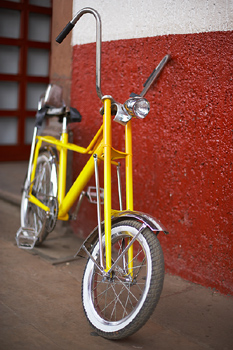
How to Paint a Bike
Apply painter’s tape to the areas of the bicycle apparatus, if there are parts you don’t want painted. Pay special attention to the forks and the bottom bracket of the bike. Also make sure to tape areas that serve as joints for screws or bolts, so that you don’t have problems rebuilding your bike after the paint procedure.
Finally, hang up your bicycle or bicycle parts by the head tube on a hanging rack, so that the paint drips downward in the same direction and does not clump on the middle of your bicycle frame.
Bicycle Primer
First, apply your rust-proof paint primer all over your bicycle’s frame. This seals your bicycle’s metal and protects it from future rust or weather damage, if applied correctly. Make sure to apply the primer in thin coats around your bicycle, so it dries before you do the actual painting.
Once again, let your bicycle hang to dry thoroughly for 24 hours, after you’ve applied the primer.
Sanding the Bike Again
Sand your bicycle’s frame with 220-grit sandpaper. This eliminates any of the bumpy imperfections that may have resulted from applying the primer to your bicycle. Sanding down your bike prepares it for the main coat of paint, to achieve maximum effectiveness.
Make sure to wipe your bicycle clean and sand dust-free before you begin painting.
Painting a Bicycle Frame
When painting a bicycle frame, first apply your main coat of paint in even layers on your bicycle. Repeat until you have applied 3 to 4 coats. If you are dealing with a patterned design, make sure your base layer is your lighter color, and always apply the darker paint last.
Wait for the paint to completely dry on the bicycle, after you have finished all the coats.
Sanding the Bicycle Once More
Take the 1200-grit sandpaper and sand down your bicycle after it dries, to get rid of the glossiness of the paint. Make sure you “wet-sand” your bike – that is, use Windex to wet the bike and sand it down with the paper, while it’s wet. This prepares your bike for the final step – applying the lacquer.
Spraying on Lacquer
Spray the lacquer onto your bicycle from a close range, to prevent your bike’s surface from acquiring a bumpy texture. Wait at least one week before you assemble your bicycle back together, to make sure the lacquer sets. It takes a long time for the lacquer to set, but it’s well worth the wait.
Putting Your Newly-Painted Bicycle Back Together
Remove the separate parts of your bicycle from their hanging racks and pay close attention to the assemblage. Buy standard grease and apply it to the bearings and other mechanisms of your bicycle to protect your bicycle’s critical functioning gears from general wear. Put your bike back together in a gentle and firm fashion.
By now, your newly painted bicycle should look as good as new. There are a lot of steps in learning how to paint a bike, but none of the steps are hard. Painting a bike takes time, but you’ll be proud of the new paint job, while enjoying the comfort of riding your old bike.
How to Replace Spark Plugs
When your car is having trouble with ignition, your spark plugs might be in need of a change. On many cars, learning how to replace spark plugs is a simple task and changing your own spark plugs saves you a trip to the auto repair or service center.
The older a spark plug gets, the more voltage it takes to get a spark. As a spark plug ages, its electrodes wear off, so it takes more voltage to get spark. Your spark plugs get to the point where they need to be replaced, but it’s a good idea to replace spark plugs periodically, before the car starts “missing”.
Many car drivers don’t check their spark plugs often, if at all. By replacing your spark plugs, you help maintain engine and fuel efficiency, as well as cold weather starting. Most of the time, bad spark plugs cause you to waste gas. If your car doesn’t start well in the cold, that’s a sign of old spark plugs.
Getting Started Replacing Spark Plugs
Changing spark plugs can be a tedious job, depending on the model of your vehicle. Some cars include spark plugs placed under the engine itself. If that’s the case, it takes a long time to change spark plugs, because you have to wait for the car to cool off before you try replacing them.
Find out where your spark plugs are, along with the size and type you need. If you get the wrong plugs at the hardware store, you could waste a lot of time on spark plug changes.
Also, find out if the spark plugs need to be gapped or not. Some newer spark plugs don’t require gapping, but it depends on the use with 6 cylinder and v-8 engines.
If you’ve been running your car for a while, park the vehicle and turn off the motor, so it can cool for several hours. To speed the cooling process, open the hood and let the cool air in.
Take a wire gauge and adjust the distance between the two electrodes. When all of this is done, start the process of replacing spark plugs. You need tools for this project, because getting your hand into such a small place can be difficult.
You need the following tools to replace spark plugs.
Removing Old Spark Plugs
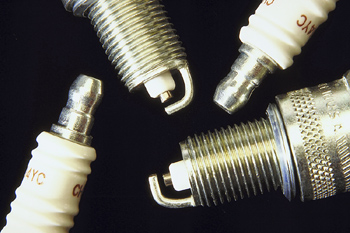
How to Replace Spark Plugs
Before you remove all of the spark plug wires, figure out which plugs are connected to which wires. Don’t replace a set of plugs all at once, if you still don’t know how to replace spark plugs. When new to removing spark plugs, work on a single plug at a time, to avoid mixing up the wires and cause misfires or engine damage.
Start at the end of the row and remove spark plugs one by one, by grasping the wire close to the engine and pulling. Don’t remove all of the wires at once, because replacing them could cost well over $100 dollars. It’s far better if you take the time to do this correctly.
Once the wire is removed, use your socket wrench with the spark plug extension to grab hold of the plug and unscrew it. Once unscrewed all the way, slowly take the plug out of its compartment.
The socket has a little bit of rubber on the inside, so when you’re unscrewing the plug, it helps to grip it. If there’s no rubber, place a piece of electrical tape into the socket.
An old spark plug looks dirty and grimy compared to the new one. If the spark plug is white or oily in texture, you may have worse problems than you thought. Make sure the end of the new spark plug is just like the old ones. Some are threaded like a screw, while others just have a snap cap on them.
Replacing Spark Plugs
Begin inserting new spark plugs. If the new spark plug matches the old one, insert it into the slot using the socket wrench. With the plug in the socket, carefully put it into the slot, making sure not to ram it or bang it into place.
If you force a spark plug into a socket, you might damage the plug, to the point where you’ll need to replace the replacement part.
Screw the plug in by hand. Once the plug meets resistance, use the socket wrench to screw it in the rest of the way, making sure it’s tight. Don’t screw the plug in too much, because you’ll damage the plug.
Continue in the same way, until all the plugs have been replaced. If your car starts up without any trouble, you know how to replace spark plugs.
How to Replace a Fuel Pump
The fuel pump is an integral part to the modern combustion engine, so you need to take good care of your car’s fuel pump. That being said, you can learn how to replace your fuel pump. Whether you replace your own fuel pump or have a mechanic do the work, check the fuel pump system every 60,000 miles.
Once your vehicle’s fuel pump gets to 100,000 miles, there’s a chance it stops working altogether, so consider an automatic fuel pump replacement around 100,000 miles. Most failing fuel pumps occur, because of the accumulation of dirt and other debris.
Dirt and grime gets into the machinery and clogs it up, making it work twice as hard and being less efficient than it normally would be.
Where to Find Your Fuel Pump
There are two different places where fuel pumps are located in a car: in the tank holding the gas, which is the most common place, and under the car itself.
How do you know your fuel pump isn’t working properly?
The first indication is poor gas mileage. If you’re getting fewer miles per gallon than you should be, it’s probably time for a tune up. If the fuel pump stops working altogether, you need to replace it.
In either case, if you can’t afford the labor, it’s easy enough to learn how to replace your fuel pump and do the work yourself, with the proper precautions. When you’ve located your fuel pump, you need the following tools, to effect repairs.
Let’s assume your fuel pump is under your car. Once all your tools are assembled, place wheel chucks behind the back tires. Place jacks near the front tires, so you can jack the car up.
Before touching anything near the fuel pump, relieve any pressure built up within the fuel lines. Fuel sprays everywhere if you don’t. There is also the risk of an explosion, if you don’t remove pressure prior to replacing any fuel lines.
Fuel Pump Replacement Instructions
The rest of this article will guide you through the fuel pump replacement instructions.
Removing the Old Fuel Pump
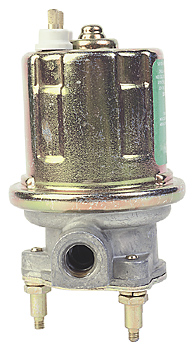
How to Replace a Fuel Pump
Start-up your car and pull the fuse for the fuel pump. If there isn’t a fuse for the fuel pump, remove the relay that controls the fuel pump. If you do this right, your engine should stall and release all of the fuel from the system.
If the fuel pump is located underneath the car, it’s going to be held in place by several bolts, which can be removed by open end wrenches.
Remove the fuel lines from the fuel pump with open end wrenches. Gas is going to start leaking. The fuel catch container underneath the pump should catch all of this.
Laying down a plastic sheet can also help, since you don’t want any of the fuel to contaminate the ground. Once you have the fuel line disconnected from the pump, remove the electrical connections. There should be two electrical connections: a negative and a positive.
Mark the electrical connections, so when you are reconnect them, you know which is which.
Installing the New Fuel Pump
Now, start installing the new fuel pump. Simply do everything you did before, except in reverse order.
Connecting the electrical wires to the new fuel pump, but make sure you connect the negative and positive wires to the correct spots. Reconnect the fuel pump, making sure that it’s connected properly, so fuel doesn’t leak everywhere, once you start the car engine again.
When everything underneath the car is reconnected to its proper place, reconnect the fuel pump fuse or fuel pump relay, depending on what you had to remove.
In-Tank Fuel Pump
If your car has a fuel pump in the gas tank, take slightly different steps. Check under the back seat or the floor of the trunk to see if there is an access panel for the tank. If there is one, replace it from there; otherwise, hoist the car and remove the tank to get to the pump.
Drain as much fuel as possible, to lighten the tank before removing it. Raise the rear end of the car and remove the tank where the filler neck is. To do this, loosen the clamp that holds the tank.
Remove only the front two or back two bolts at a time, so you can reach the wires and fuel pump and vent hoses. Disconnect the wires and hoses before removing the other two bolts. Lower the tank.
When the tank is on the ground, remove the cover plate. Pull the pump and wires out of the tank. Once you have the new pump in the tank, raise it high enough to can connect the wires, fuel line and vent hoses.
Finish raising the fuel pump all the way, then connect the support straps. Reconnect the filler tube and check the tank for leaks, which is the last step. After finishing these steps, you now know how to replace your fuel pump.
